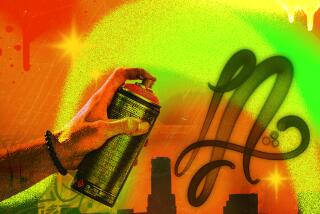WESTSIDE / COVER STORY : thE SliCKSter Of gRUnge HEA Publisher Marvin Jarrett Seeks ‘the Most Visually Exciting Piece of Paper That Anyone Has Ever Seen’
To some, Marvin Scott Jarrett runs the coolest magazines on earth.
They are so cool that it doesn’t matter that they can be hard to read, that they cater to a fairly narrow audience with a fairly narrow range of concerns and, more often than not, are audacious but dizzying jumbles of type, color and images.
What other magazine can claim Michael Stipe of REM as a contributing photographer? (He called and asked for the job, Jarrett said.) Or has Thurston Moore of Sonic Youth waxing philosophic over model Liv Tyler? Or have actresses Tatum O’Neal and Traci Lords in semi-nude pictorials? Where even the notoriously press-wary Eddie Vedder of Pearl Jam contributes a Q & A with one of his favorite bands?
Only in Ray Gun. And only in Bikini.
“I wanted to create the coolest magazine possible . . . the most visually exciting piece of paper that anyone has ever seen,” said Jarrett, the 34-year-old editor-publisher who began Santa Monica based-Ray Gun Publishing Co. three years ago. “The idea was for them not to look like any other magazines.”
Mostly they don’t.
As outre incarnations of the products and attitudes of Generation X, Ray Gun and Bikini have become to more than 100,000 readers the premier arbiters of hip, perched on the cutting edge of the cutting edge.
Combining the look of in-your-face fashion/lifestyle magazines such as Emigre and The Face with the “do-it-yourself” ethic of punk publications (so-called zines), Ray Gun and Bikini have managed a neat double trick: capturing the style of grunge and the insouciant disaffection of Gen-X, and simultaneously marketing the look nationwide in chain bookstores, and on newsstands throughout Europe.
Though some carp about the magazines’ lack of substance, their subject matter has struck a resounding chord in the fickle magazine industry. Ray Gun bills itself as “The Bible of Music + Style and The End of Print”; Bikini’s statement of purpose is “Action. Film. Cars. Rock N Roll.”
“They have changed the way magazines look, the way New York magazine did in the ‘60s and Esquire did in the ‘70s,” said Steve Heller, editor of the AIGA (American Institute of Graphic Design) Journal of Graphic Design.
“Ray Gun is the visual, typographical manifestation of the generation that it is appealing to. It’s pushing graphic presentation into the realm of multimedia, except that it’s on a single sheet. It’s really about now, just as the psychedelic poster was about 1968.”
Between the two publications, there are several significant differences. The large format Ray Gun, begun 2 1/2 years ago, is more of a straight music magazine for the alternative crowd, though it will never be mistaken for Spin or Rolling Stone.
Ray Gun’s title, says Jarrett, owes nothing to the punk band Naked Raygun or the name of the former President--it was just a term “weird enough to get people to return my calls.”
Bikini, meanwhile, is an explicit attempt to tweak the libido of 18- to 29-year-old males. Referred to by media and culture watchers as “the Playboy for the ‘90s,” the squared-off Bikini runs the occasional semi-nude pictorial and has an added emphasis on high-risk sports and adventure. Indeed, Bikini’s first issue in November, 1993, featured actor Tim Roth on the cover and on the inside a pictorial of a nude, mud-slathered Alyssa Milano, the actress.
Jarrett recently added another music-oriented magazine, titled Huh. It is bankrolled by conglomerate Time-Warner and focuses on all styles of new music--not just alternative rock--with an emphasis on getting readers to order products by the musicians written about in each issue. Fueled by the marketing resources of its giant parent, which has advertised the magazine in TV Guide, Rolling Stone, Interview and, of course, on MTV, Huh has 350,000 subscribers after just six months.
And Jarrett has more.
In April, Ray Gun is scheduled to go live on the Internet--in effect, delivering more graphics, text and video to computer users worldwide. Jarrett also is in discussions with MTV Europe about a project for them; a CD-ROM magazine is being planned, as well. And though the prospects of television and film projects are premature, he is amenable to talk of eventually bringing such ventures into the alternative Ray Gun fold.
Such projects are a far cry from the zine world, where the usual low-budget publications are the product of a small handful of people, or sometimes just one person. Nevertheless, Jarrett sees his work as being in that same spirit.
“We’re a youth culture publishing company,” said Jarrett, whose wife, Jaclynn, is associate publisher of the magazines. At the end of each publishing day, he said, the motto in the office is still, “It’s only rock ‘n’ roll.”
*
Marvin Jarrett is the quintessential Angeleno, which is to say that he was born and reared somewhere else--Pennsylvania and then central Florida. Jarrett, in fact, didn’t move to Los Angeles until he was in his late 20s, after a serpentine career path that included stops in Hawaii and Florida selling advertising time on rock radio stations before working at Creem magazine--first as its West Coast advertising manager, then as publisher-executive editor.
It was at Creem that Jarrett, a former garage band guitarist, got his first taste of music magazine publishing and decided to forge ahead on a publication of his creation. The first issue of Ray Gun, produced in the dining room of the Jarretts’ one-bedroom Beverly Hills apartment, debuted in September, 1992. It cost $100,000, had singer/writer Henry Rollins on the cover and, upon request by bookstore chains, doubled its original printing to 60,000 copies. At $3.50 a copy--which remains its price--it sold out in the nation’s major metropolitan areas.
“I thought this . . . was worth every penny,” said Jarrett, who recalls going to Ehrlinger, Ky., where the magazine was printed and watching the huge presses roll out the debut copy of his magazine. “That was a pretty cool feeling.”
Most of Ray Gun’s initial splash came from its look, which in turn came from a highly influential but short-lived publication called Beach Culture. A celebration of the beach lifestyle and its accompanying attitudes and sports -- surfing, skating and snowboarding -- the Orange County-based magazine was a startling mix of unorthodox typefaces--dubbed “garage fonts”--off-kilter imagery and an intensity about its subject matter. The art director was David Carson, and Jarrett tapped both Carson and Neil Feineman, a Beach Culture editor, to imprint their style upon Ray Gun.
Feineman left after four issues, claiming the original vision that brought him to Ray Gun was being changed to emphasize graphics at the expense of editorial content. (The magazine’s slogan alluding to “the end of print,” he notes wryly, was a later addition).
Carson is still art director and recently had some of his Ray Gun work displayed in gallery and museum shows in Osaka, Japan, and London.
Jarrett, however, was already working on plans for Bikini, which appeared in 1993, a year after Ray Gun. Subsequently, Huh debuted last year, which makes one new magazine a year for Jarrett. “I get most excited about new projects,” he said.
These days, however, much of the new thinking around Ray Gun Publishing is being devoted to the original product. After 24 issues, Jarrett is initiating an extensive remake, prompted mostly by the fact that the conventional--or mainstream--media has caught up with it.
“We’re being copied everywhere,” Jarrett said. “When you see AT&T; commercials being influenced by Ray Gun, you know it’s time to move on.”
Though the redesign is still being worked out, Jarrett promises a cleaner and less frantic look, with more color and fewer of the typeface experiments--including changing fonts in mid-sentence--that now characterize the magazine.
It is, he concedes, a “more accessible, modern look,” but one that he feels no need to apologize for. In fact, Jarrett acknowledges that the traditional dichotomy between commerce and the underground is one that doesn’t exist for him. Following in the wake of MTV, which has been instrumental in propelling unknown grunge bands to the top of the charts, Jarrett endorses the notion of “alternative music” growing to encompass as large a following as possible.
“It’s an outdated concept that you have to have a small audience to maintain artistic integrity,” said Jarrett, who also lists with pride the major advertisers--Philip Morris, for example--that buy space in Ray Gun and Bikini. “(Everyone’s) just looking to take the next edgy thing to the mainstream.”
It is an attitude, though, that has made Jarrett the target of criticism. After he and a partner bought and resurrected Creem magazine in 1990, for example, stalwart fans of the old magazine, and some musicians, complained that the new Creem was slick and soulless, and overly stuffed with photos. After seeing the first copy, producer/musician Don Was cracked: “It’s like opening the Berkeley Barb and seeing an Absolut vodka ad.”
Similarly, Ray Gun and Bikini have received their share of brickbats.
Feineman, the former editor and a self-proclaimed “old hippie,” makes no attempt to mask his dislike of the magazines, which he says have all but forsworn meaningful editorial content. Even design critic Heller admits he doesn’t read Ray Gun, “I just look at it.” Ultimately, said Feineman, “(the magazines) don’t spring from any other need than to make money.”
“The way I understand alternative is that it means passion, rebellion . . . and a feeling that you’re speaking to disenfranchised people about issues that transcend materialism and corporate America,” Feineman said. “These magazines package rebellion in a way that makes it palatable and unthreatening, and an unwitting arm of the status quo.”
Art Chantry is likewise disaffected. A nationally acclaimed Seattle-based graphic designer, Chantry takes issue with the magazines’ cachet, or street credibility. The design style of Ray Gun, he said, was born of a goof, of an attempt to “do everything as wrong as possible.”
That it has been adopted by other media as a carefully studied style is “kind of scary,” he said.
“As far as mainstream ‘cred’ goes, (Ray Gun) is very hip,” Chantry said. “As far as underground ‘cred’ goes, it’s a joke.”
*
Jarrett is all too aware that publications that document the splatter of pop culture are vulnerable to the culture’s ever-shrinking attention span and constant hunger for the shock of the new. But the potential of that happening, he said, is averted by closely watching those for whom pop culture is not just an artifact but a way of life.
Given the enthusiasm and time needed to make such a life, those people are invariably young, mostly early 20s. Jarrett points out that the managing editor of Bikini is a 23-year-old. And Jarrett says he cultivates input from the magazines’ high school-aged interns to keep his publications fresh. Though acknowledging that he wants Ray Gun to be a “ ‘90s Rolling Stone,” it is this conscious--one might say, obsessive--attention to youth that keeps the magazines edgy.
“When I started Bikini, I had five or six guys in their 20s talking about what a cool magazine should be,” he said. “That’s the difference between us and Hearst (publishing.)”
He adds: “It was a zine philosophy behind Ray Gun. We just did it on a grander scale. The essence of the zine is that people are putting something out that is a part of them.”
In that, Jarrett is unassailable. Though some argue that he is retailing grunge--much like fashion editors who spotlight the look regardless of how they might dress, or even how they view style--Jarrett’s concern is the visual impact. And in that, Ray Gun, Bikini and Huh are all indisputably Marvin Jarrett zines.
“I don’t profess to be the arbiter of cool,” Jarrett said. “But I think what we do is cool.”
More to Read
Sign up for our Book Club newsletter
Get the latest news, events and more from the Los Angeles Times Book Club, and help us get L.A. reading and talking.
You may occasionally receive promotional content from the Los Angeles Times.







